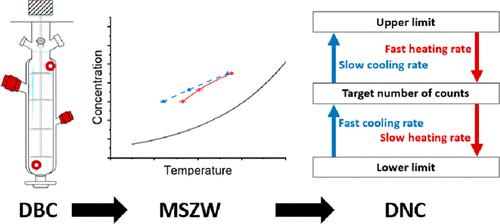当前位置:
X-MOL 学术
›
Org. Process Res. Dev.
›
论文详情
Our official English website, www.x-mol.net, welcomes your
feedback! (Note: you will need to create a separate account there.)
Strategy for Non-Seeded Crystallization of Slow-to-Crystallize Compounds with an Oscillatory Dynamic Baffled Crystallizer: A Case Study with α-Lactose Monohydrate
Organic Process Research & Development ( IF 3.1 ) Pub Date : 2022-08-01 , DOI: 10.1021/acs.oprd.2c00043 Christine Darmali 1 , Yiqing Claire Liu 2 , Shahnaz Mansouri 3 , Nima Yazdanpanah 4 , Zoltan K. Nagy 2 , Meng W. Woo 1, 5
Organic Process Research & Development ( IF 3.1 ) Pub Date : 2022-08-01 , DOI: 10.1021/acs.oprd.2c00043 Christine Darmali 1 , Yiqing Claire Liu 2 , Shahnaz Mansouri 3 , Nima Yazdanpanah 4 , Zoltan K. Nagy 2 , Meng W. Woo 1, 5
Affiliation

|
This study aims to evaluate a suitable operating strategy to produce slow-to-crystallize particles in the oscillatory dynamic baffled crystallizer (DBC) by taking a lactose compound as a case study. Metastable zone width (MSZW) determination experiments were conducted with three different supersaturated concentrations (0.6, 0.73, and 0.9 kg/kg solvent) at fast cooling (0.2 °C/min) and slow cooling (0.05 °C/min). A narrower MSZW was attained in the DBC than that in a stirred tank crystallizer due to the intensive mixing created by the oscillatory flow. The results showed that the DBC conditions evaluated at a higher initial supersaturation would allow fast cooling to approach the behavior of slow cooling. Such convergent behavior was observed in terms of the particle size distribution (PSD) and the resultant apparent MSZW. Despite the slightly lower yield attained with fast cooling, the significantly shorter required crystallization time would effectively allow higher production throughput than slow cooling. A high mixing intensity in the DBC showed that lactose crystallization was prone to secondary nucleation, which produced a broad PSD. A direct nucleation control (DNC) strategy was further adopted to push the boundary of the fast cooling–high initial supersaturation crystallization strategy. While the DNC strategy led to a narrower PSD and a similar high yield as the slow cooling–high initial supersaturation, the overall particle size was unexpectedly shifted to a relatively smaller range. These findings can be used as a basis to improve the lactose crystallization process by further investigating the secondary nucleation threshold of lactose in a DBC to attain larger crystals.
中文翻译:

采用振荡动态挡板结晶器的慢结晶化合物的非晶种结晶策略:以 α-乳糖一水合物为例
本研究旨在通过以乳糖化合物为案例研究,评估在振荡动态挡板结晶器 (DBC) 中生产慢结晶颗粒的合适操作策略。在快速冷却 (0.2 °C/min) 和缓慢冷却 (0.05 °C/min) 下,使用三种不同的过饱和浓度(0.6、0.73 和 0.9 kg/kg 溶剂)进行亚稳态区宽度 (MSZW) 测定实验。由于振荡流产生的强烈混合,DBC 中的 MSZW 比搅拌槽结晶器中的更窄。结果表明,在较高的初始过饱和度下评估的 DBC 条件将允许快速冷却接近缓慢冷却的行为。在粒度分布 (PSD) 和所得的表观 MSZW 方面观察到这种收敛行为。尽管快速冷却获得的产率略低,但所需的显着缩短的结晶时间将有效地允许比缓慢冷却更高的生产量。DBC 中的高混合强度表明乳糖结晶易于发生二次成核,从而产生较宽的 PSD。进一步采用直接成核控制(DNC)策略来推动快速冷却-高初始过饱和结晶策略的边界。虽然 DNC 策略导致更窄的 PSD 和与缓慢冷却 - 高初始过饱和度相似的高产率,但总体粒度出乎意料地转移到了相对较小的范围。
更新日期:2022-08-01
中文翻译:

采用振荡动态挡板结晶器的慢结晶化合物的非晶种结晶策略:以 α-乳糖一水合物为例
本研究旨在通过以乳糖化合物为案例研究,评估在振荡动态挡板结晶器 (DBC) 中生产慢结晶颗粒的合适操作策略。在快速冷却 (0.2 °C/min) 和缓慢冷却 (0.05 °C/min) 下,使用三种不同的过饱和浓度(0.6、0.73 和 0.9 kg/kg 溶剂)进行亚稳态区宽度 (MSZW) 测定实验。由于振荡流产生的强烈混合,DBC 中的 MSZW 比搅拌槽结晶器中的更窄。结果表明,在较高的初始过饱和度下评估的 DBC 条件将允许快速冷却接近缓慢冷却的行为。在粒度分布 (PSD) 和所得的表观 MSZW 方面观察到这种收敛行为。尽管快速冷却获得的产率略低,但所需的显着缩短的结晶时间将有效地允许比缓慢冷却更高的生产量。DBC 中的高混合强度表明乳糖结晶易于发生二次成核,从而产生较宽的 PSD。进一步采用直接成核控制(DNC)策略来推动快速冷却-高初始过饱和结晶策略的边界。虽然 DNC 策略导致更窄的 PSD 和与缓慢冷却 - 高初始过饱和度相似的高产率,但总体粒度出乎意料地转移到了相对较小的范围。









































 京公网安备 11010802027423号
京公网安备 11010802027423号